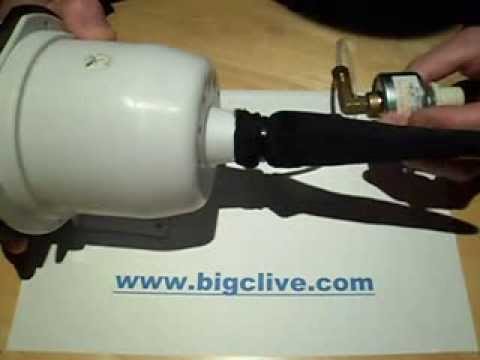This is a quick look at the inside of a standard foam style snow machine. These machines work by blowing air forcibly into and around a sock of fabric while also pushing a very dilute detergent liquid (mostly water) into it. The detergent is carried to any area of the sock where air is flowing through, meaning that it automatically covers the entire inside of the sock and as the air pushes through with the detergent it forms a thick foam on the surface. That foam is then stripped off as tiny flakes by an external airflow and blown out the front of the machine producing an extremely convincing snow effect. The foam really flutters and floats like real snow, and gradually disappears when it lands. If these machines are used at height the snow really drifts and swirls with the wind.
I was using an ultra high power industrial-grade snow machine on a show recently and it was basically the exact same principle scaled up. A blower was used to create the foam, but there was no pump. Just a fine control valve, and the liquid was drawn in by the negative pressure created by the air flowing past the feed tube. The foam was launched out by a huge centrifugal fan that took up most of the space inside the heavy unit.
These machines use the effect fluid at an alarmingly high rate, and as always the suppliers try to pretend that the fluid is “special” and charge a premium for it. In reality it’s usually about 99% water with a small amount of surfactant and sometimes a preservative too. Surfactants are a type of chemical that form a bond with both water and oils and naturally form foams. If you look at any shampoo or hand soap the first ingredient will be water (aqua) usually followed by the surfactant, usually sodium laureth sulfate and perhaps cocamidopropyl betaine. Everything else in the shampoo is thickener, aroma, colour and preservative. For some specialist applications an alcohol will also be added to encourage faster evaporation of the water with the added advantage of making the snow appear fluffier and lighter as it dries in the air.
If you make your own fluid, either by diluting shampoo (baby shampoo is a good idea) then don’t leave the fluid in the machine for a prolonged period of time as it may grow slimy mould. It’s a good idea to flush the machine through with a good proprietary fluid before storage to protect the pump from yuck. If that fails (and the pumps often do jam up) then look in my videos for a guide to stripping and cleaning them.
Share
How a snow machine works.04:33
Published on February 2, 2018

